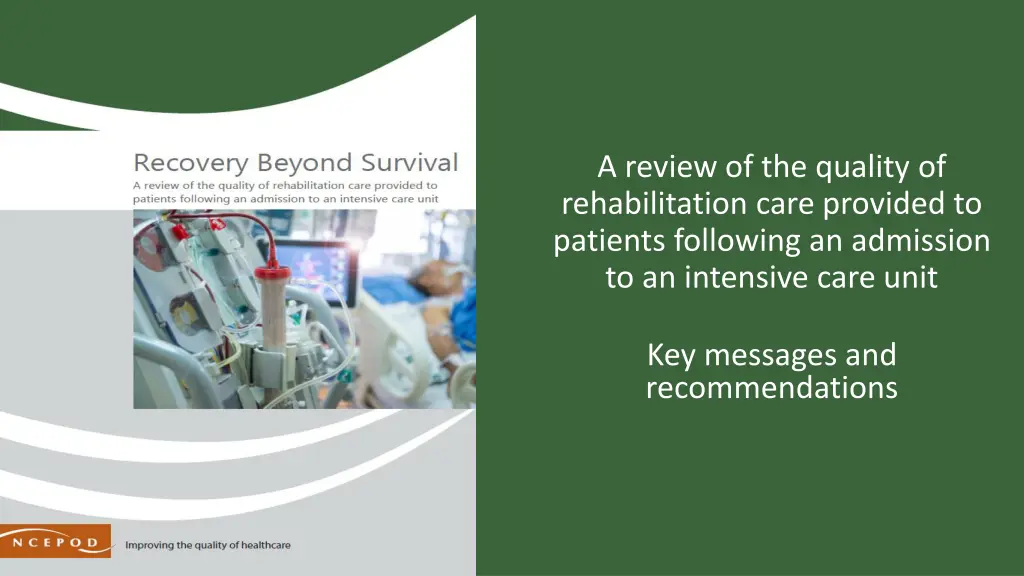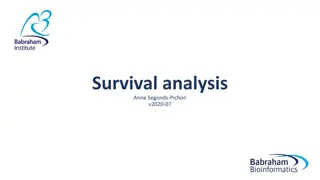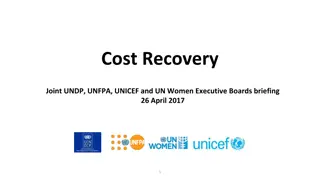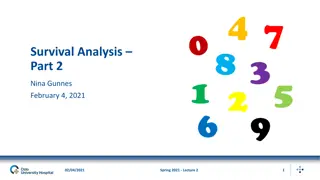
Quality of Rehabilitation Care Following ICU Admission: Key Messages and Recommendations
A review of the quality of rehabilitation care provided to patients post-ICU admission reveals challenges in coordination, assessment, and multidisciplinary team involvement. Recommendations focus on improving care pathways and setting/revising rehabilitation goals.
Download Presentation

Please find below an Image/Link to download the presentation.
The content on the website is provided AS IS for your information and personal use only. It may not be sold, licensed, or shared on other websites without obtaining consent from the author. If you encounter any issues during the download, it is possible that the publisher has removed the file from their server.
You are allowed to download the files provided on this website for personal or commercial use, subject to the condition that they are used lawfully. All files are the property of their respective owners.
The content on the website is provided AS IS for your information and personal use only. It may not be sold, licensed, or shared on other websites without obtaining consent from the author.
E N D
Presentation Transcript
A review of the quality of rehabilitation care provided to patients following an admission to an intensive care unit Key messages and recommendations
The study Study population: All patients aged 18 and over who were admitted as an emergency to an ICU for four or more days between 1st October 2022 and 31st December 2022 and who survived to hospital discharge. Data sources: 671 clinician questionnaires 365 sets of case notes 166 organisational questionnaires 248 primary care questionnaires 67 community trust questionnaires 102 patient and 420 healthcare professional survey responses
Data returns 7,187 patients identified 113 patients excluded for not meeting the inclusion criteria 1,018 patients included 365 sets of case notes 671 clinician questionnaires 248 primary care clinician questionnaires
Rehabilitation care was not well co-ordinated throughout the pathway; on admission to an ICU, at step-down to the ward and in the community. 1 IN INTENSIVE CARE: 70/166 (42.2%) organisations had a policy or standard operating procedure for the delivery of rehabilitation, and only 24/70 undertook audits against them. ON THE WARD AND AFTER DISCHARGE The data showed an absence of good multidisciplinary team working and communication across the recovery pathway as the patient moved between healthcare settings. Key workers to co-ordinate rehabilitation care were rarely available, yet when present they were associated with improved markers of care quality throughout the rehabilitation pathway.
2 Initial and subsequent assessments of rehabilitation need to set/update goals were not always undertaken. IN INTENSIVE CARE: 104/365 (28.5%) patients had a baseline screen, and 327/574 (57.0%) patients had a comprehensive assessment on the ICU. ON THE WARD 80/309 (25.9%) patients had a comprehensive assessment on the ward. AFTER DISCHARGE 102/210 (48.6%) patients who attended a critical care follow-up following discharge were comprehensively reassessed.
Full multidisciplinary team (MDT) input was rarely available to meet all the rehabilitation needs of patients. 3 IN INTENSIVE CARE: Physiotherapists were most involved in rehabilitation (604/671; 90.0%); other specialties, such as psychologists (37/671; 5.5%) much less so. ON THE WARD 111/318 (34.9%) patients had input from the ICU MDT; usually an intensive care nurse (70/111; 63.1%) or critical care outreach (44/111; 39.6%) with less focus on rehabilitation. AFTER DISCHARGE 98/254 (18.2%) patients did not have all appropriate referrals made.
Ongoing rehabilitation needs/goals were often not shared between healthcare providers as the patient moved through the pathway. 4 IN INTENSIVE CARE: 125/671 (18.6%) patients had no evidence of any handover related to rehabilitation needs. ON THE WARD 357/576 (62.0%) patients were provided with an ICU follow-up appointment. AFTER DISCHARGE GPs were aware that a patient they saw had spent time in the ICU in 170/248 (68.5%) cases.
Information for the patient or their family about the ICU admission and any lasting impact it may have was limited. 5 IN INTENSIVE CARE: The patient and their family were updated in 165/302 (54.6%) instances. ON THE WARD 131/435 (30.1%) patients were given a copy of the ICU discharge summary. AFTER DISCHARGE 40/102 (39.2%) survey respondents reported they were given a leaflet or discharge booklet.
Co-ordinate rehabilitation throughout the pathway Improve the co-ordination and delivery of rehabilitation following critical illness at both an organisational level and at a patient level. At an organisational level by assigning a trust/health board rehabilitation lead with oversight and responsibility for the provision of holistic rehabilitation. At a patient level by having a named rehabilitation care co-ordinator(s) role to oversee patients rehabilitation needs within the ICU, on the ward and in the community. For action by: Commissioners, integrated care boards, hospital trusts/health boards Additional stakeholders: Intensive Care Society, Faculty of Intensive Care Medicine, British Dietetic Association, Royal College of Speech and Language Therapists, Royal College of Occupational Therapists, Chartered Society of Physiotherapists.
Standardised rehabilitation screening tool Develop and validate a national standardised rehabilitation screening tool to be used on admission to an intensive care unit. This would identify patients at risk of long-term physical, psychological, cognitive or social effects and trigger an earlier comprehensive assessment of their rehabilitation needs sooner than day four currently defined by NICE Quality Standard 158. For action by: Intensive Care Society, Faculty of Intensive Care Medicine, National Institute of Health Research (area of potential research), NHS England, Welsh Government, Health Department of Northern Ireland, Jersey. Additional stakeholders: Commissioners, integrated care boards (England), Royal College of Speech and Language Therapists, Royal College of Occupational Therapists, Chartered Society of Physiotherapists British Dietetic Association, Royal College of Psychiatrists, Association of Clinical Psychologists-UK, British Association of Critical Care Nurses, UK Critical Care Nursing Alliance.
Comprehensive, holistic rehabilitation needs assessment Undertake and document a comprehensive, holistic assessment of the rehabilitation needs of patients admitted to an intensive care unit at risk of physical and/or non- physical morbidity. Assessments should be repeated and documented at key stages along the patient s pathway from admission to community services and GP follow-up. NB: The assessment should be undertaken by day four following admission (in line with NICE Quality Standard 158) or sooner if the patient is identified as needing a more comprehensive assessment at the screening stage (see recommendation 2), noting that elements of the assessment not possible by day four (e.g. swallow if the patient is orally intubated) should be completed as soon as clinically possible. For action by: Healthcare professionals involved with patients on the intensive care unit. Additional stakeholders: Executives in trust/health boards, Royal College of Speech and Language Therapists, Royal College of Occupational Therapists, Chartered Society of Physiotherapists British Dietetic Association, Royal College of Psychiatrists, Association of Clinical Psychologists-UK, British Association of Critical Care Nurses, UK Critical Care Nursing Alliance.
Multidisciplinary team care delivery Ensure that multidisciplinary teams are in place to deliver the required level of rehabilitation in intensive care units and across the recovery pathway. Include: All relevant healthcare professionals needed to provide co-ordinated, consistent care in the ICU, ward and community Regular communication between specialties and discussion of patients needs at a dedicated multidisciplinary team meeting or rehabilitation rounds when appropriate Staff to deliver the required rehabilitation. For action by: Commissioners, integrated care boards. Additional stakeholders: Hospital trusts/health boards, Royal College of Speech and Language Therapists, Royal College of Occupational Therapists, Chartered Society of Physiotherapists British Dietetic Association, Royal College of Psychiatrists, Association of Clinical Psychologists-UK, British Association of Critical Care Nurses, UK Critical Care Nursing Alliance.
Standardise rehabilitation needs and goals handover Standardise the handover of rehabilitation needs and goals for patients as they transition from the intensive care unit to the ward and ward to community services. For action by: Healthcare professionals involved with patients on the intensive care unit and hospital trusts/health boards. Additional stakeholders: Intensive Care Society, Faculty of Intensive Care Medicine, Royal College of Speech and Language Therapists, Royal College of Occupational Therapists, Chartered Society of Physiotherapists British Dietetic Association, Royal College of Psychiatrists, Association of Clinical Psychologists-UK, British Association of Critical Care Nurses, UK Critical Care Nursing Alliance.
Communication with patients Provide patients and their family/carers with clear information about their admission to an intensive care unit, impact of critical illness and likely trajectory of recovery. Include the contact details of a named healthcare professional or rehabilitation care co-ordinator Involve patients/family/carers in multidisciplinary team discussions and rehabilitation planning. For action by: Healthcare professionals involved with patients on the intensive care unit and hospital trusts/health boards, integrated care boards, and patient organisations. Additional stakeholders: Intensive Care Society, Faculty of Intensive Care Medicine, ICUsteps.
REPORT and TOOLS www.ncepod.org.uk/2025icur.html Report Summary Infographic Recommendation checklist Audit tool Driver diagram Fishbone diagram Commissioners guide






















